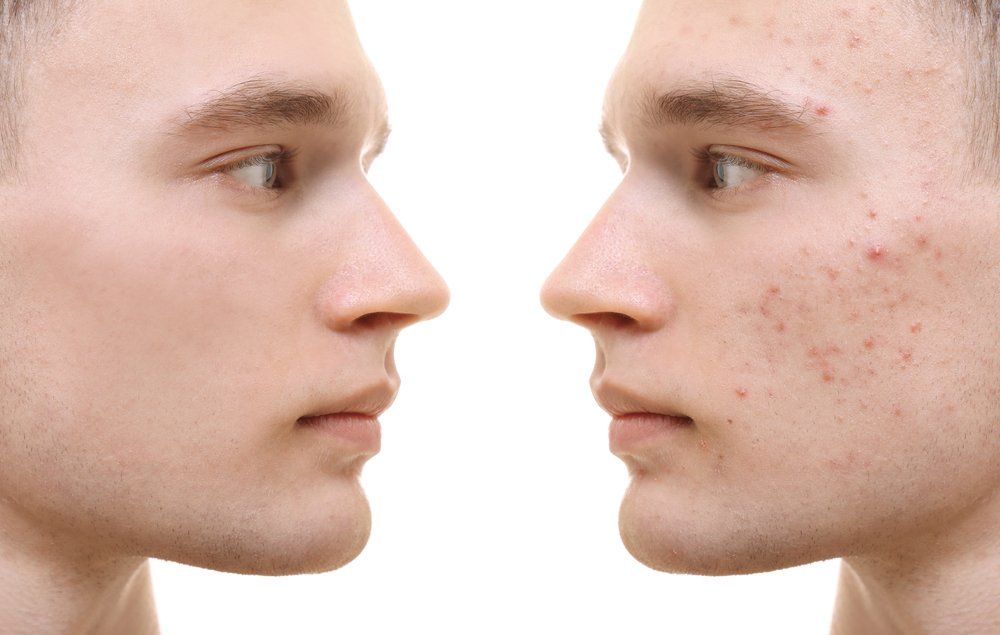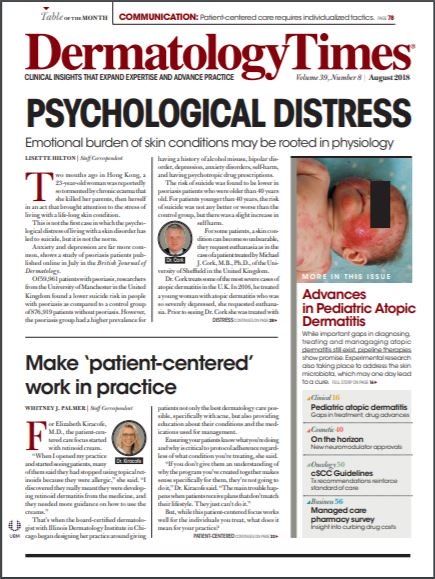- Acne
- Actinic Keratosis
- Aesthetics
- Alopecia
- Atopic Dermatitis
- Buy-and-Bill
- COVID-19
- Case-Based Roundtable
- Chronic Hand Eczema
- Drug Watch
- Eczema
- General Dermatology
- Hidradenitis Suppurativa
- Melasma
- NP and PA
- Pediatric Dermatology
- Pigmentary Disorders
- Practice Management
- Precision Medicine and Biologics
- Prurigo Nodularis
- Psoriasis
- Psoriatic Arthritis
- Rare Disease
- Rosacea
- Skin Cancer
- Vitiligo
- Wound Care
Publication
Article
Dermatology Times
The science behind acne scarring
Author(s):
The intensity and duration of the inflammatory reaction in acne causes dermal damage and alteration of the sebaceous gland structure leading to atrophic scar formation, but not all patients are affected equally.
The intensity and duration of the inflammatory reaction in acne causes dermal damage and alteration of the sebaceous gland structure leading to atrophic scar formation, but not all patients are affected equally. (©AfricaStudio/Shutterstock.com)

The inflammatory response in papules of patients with acne prone to scarring can last more than three weeks and is characterized by a marked infiltration of B cells, a study published in the British Journal of Dermatology has found, whereas the immune response in papules of patients with acne not prone to scarring resolves much more rapidly.
The researchers suggested that the intensity and duration of this inflammatory reaction causes dermal damage and alteration of the sebaceous gland structure leading to atrophic scar
formation.
While the pathogenesis of atrophic acne scarring is not completely understood, severity and duration of inflammation is considered likely to play a role.
One previous study analyzed the immune response in acne scarring by comparing acne lesions in scar-prone and non-scar-prone patients, and found that in the first seven days the inflammatory reaction around the pilosebaceous follicle was stronger and lasted longer in patients with scarring.
THE STUDY
For this current study, researchers wanted to look at the immune response over a longer period. They analyzed the pathophysiologic mechanisms occurring in scar prone and non-scar prone acne patients in lesions of three weeks by performing large scale gene expression profiling to identify molecular and cellular pathways that may account for the predisposition to scar formation. Then then used immunohistochemistry techniques to confirm their results.
Nineteen patients with moderate inflammatory acne as defined by the ECLA score, were enrolled in the study with 10 prone to scarring and nine were not. Biopsies of non-lesional skin and of inflammatory lesions less than 48 hours old were taken from their backs, and further lesions less than 48 hours old were identified for follow up 21 days later. Biopsies of these “evolved lesions” were taken at 21 days.
Biopsies were also from ten healthy volunteers to provide a comparison of healthy skin, and skin samples were obtained from five healthy people undergoing plastic surgery for gene expression profiling of human sebaceous glands and epidermis.
Gene expression and immunohistochemistry analyses showed a very similar immune response in 48 hours-old papules in scar prone and non-scar prone patients with acne, characterized by elevated numbers of T cells, neutrophils and macrophages.
However, when the three-week old papules were examined, it was clear that the immune response persisted only in scar prone patients, and an infiltrate of B cells was evident.
Down-modulation of sebaceous gland markers related to lipid metabolism was observed in 48 hours-old papules in non-scar prone patients, but this had normalized after three weeks. In contrast, there was a drastic reduction of these markers in scar prone patients which persisted at three weeks, suggesting “an irreversible destruction of sebaceous gland structures after inflammatory remodelling in scar-prone acne patients”, the researchers said.
“We demonstrated that the inflammatory response is still present in 21-days lesions in acne patients prone to scarring compared to those who do not develop scars, suggesting a difference in the acne lesion life-cycle between the two populations,” Dr Johannes Josef Voegel said.
“Inflammatory lesions persist after three weeks only in patient with scars, with an exacerbation of number and modulation of genes involved in the immune response. This was in line with higher influx of T cells and macrophages observed by immunohistochemistry.”
A lack of neutrophils in the three-week papules of scar prone patients showed the persistence of an adaptive immune response, he added, suggesting “either a non-elimination of the trigger factor and/or an absence of inflammation resolution signals or inappropriate immune response.” However, the infiltrate of mature B cells and strong expression of several immunoglobulin genes was unexpected, he said.
B CELLS
B cells have diverse functions in the adaptive immune system and have been observed in chronic inflammatory skin conditions such as atopic dermatitis. They may contribute to the skin-specific immune response by producing local antibodies and exhibiting either pro-inflammatory or anti-inflammatory activities, Dr Voegel said. “The influx of mature B cells occurs late in acne lesion cycle and only in long-lasting lesions of patients with scarring. It is currently unclear whether the flux of B cells in older acne lesions contributes to sustaining the immune response or to dampening the inflammation via anti-inflammatory mechanisms.”
There is growing evidence suggesting that B cells might be as important as T cells in the pathogenesis of several inflammatory skin diseases, including autoimmune blistering disorders, psoriasis and atopic dermatitis.
“In late-stage acne lesions, B cells might fulfil both antibody-dependent and independent roles in the maintenance of skin immunity and inflammation. Additionally, B cells by producing cytokines regulate collagen synthesis by fibroblasts and thus could contribute to the scarring process,” he suggested.
GENE EXPRESSION PROFILE
The difference in the gene expression profile of 48 hour and 21-day lesions in scar prone patients indicated profound remodelling of the skin, the researchers suggested. In particular, the dramatic down-modulation of a lipid-associated gene set, which is preferentially expressed in human sebaceous glands, supports the disappearance of sebaceous glands in atrophic acne scars.
They speculated that dermal thinning is caused by a loss of pilosebaceous units and insufficient replacement of dermal matrix. Disappearance of sebaceous glands has also been noted in viral infection of the epidermis by herpes zoster (varicella) which has a potential to scar.
“By extension, in the acne population prone to scarring, the destruction of sebaceous glands by an exacerbated inflammatory response can result in atrophic scar formation. The destruction of the entire pilo-sebaceous unit causes a loss of dermal continuity, which is later filled with granulation tissue. At the end of the healing process the granulation tissue shrinks, resulting in atrophic scar formation,” they proposed.
References:
Carlavan I, Bertino B, Rivier M, Martel P, Bourdes V, Motte M, Déret S, Reiniche P, Menigot C, Khammari A, Dreno B, Fogel P, Voegel JJ. Atrophic scar formation in acne patients involves longâacting immune responses with plasma cells and alteration of sebaceous glands. British Journal of Dermatology 2018 doi: 10.1111/bjd.16680
Holland DB, Jeremy AHT, Roberts SG, et al. Clinical and Laboratory Investigations Inflammation in acne scarring: A comparison of the responses in lesions from patients prone and not prone to scar. Br J Dermatol 2004; 150:72–81.

Newsletter
Like what you’re reading? Subscribe to Dermatology Times for weekly updates on therapies, innovations, and real-world practice tips.

























